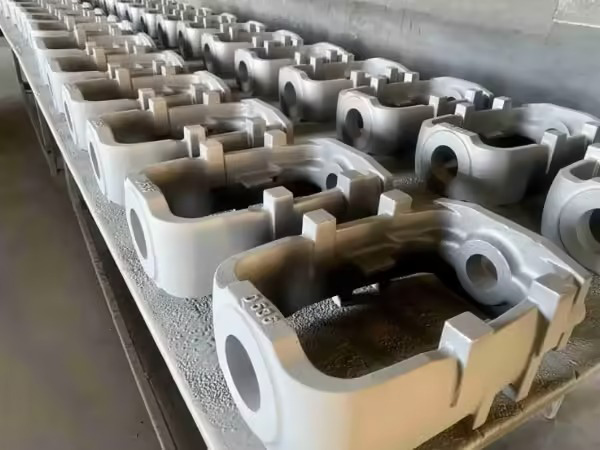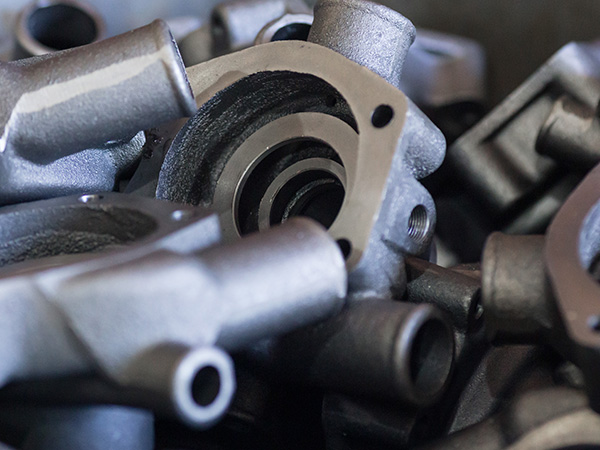Elektronikindustrie
Produktinformationen herunterladen
Um unseren Kunden weltweit ein besseres Verständnis unserer Produkte zu ermöglichen, möchten wir Ihnen detaillierte Produktinformationen zur Verfügung stellen, die Ihnen bei der Auswahl der Produkte helfen, die Ihren Anforderungen entsprechen.
Vorteile
The electronics industry is a high-tech sector that integrates precision manufacturing, materials science, and functional design. As electronic devices evolve towards miniaturization, lightweighting, high performance, and efficient heat dissipation, extremely high demands are placed on the precision, strength, and thermal conductivity of metal components.
Casting plays a vital role in the electronics industry, enabling the one-step molding of complex structures with high dimensional accuracy and excellent surface quality. Its applications range from electronic component brackets to device housings, providing critical support components for 5G communications equipment, industrial control systems, smart terminals, and electronic modules in new energy vehicles.
Casting plays a vital role in the electronics industry, enabling the one-step molding of complex structures with high dimensional accuracy and excellent surface quality. Its applications range from electronic component brackets to device housings, providing critical support components for 5G communications equipment, industrial control systems, smart terminals, and electronic modules in new energy vehicles.

Application of Casting in Electronic Component Manufacturing
Leierwo can customize various types of electronic component castings. Our products are widely used in: electronic components, electronic equipment housings, structural support parts, radiators, etc.
Typical Casting Products Include
Electronic device housings (communication module housings, control unit housings, sensor housings).
Heat dissipation components (power module heat sinks, LED heat sinks, electronic chassis thermal pads).
Support and connector components (shielding shells, brackets, grounding frames, mounting bases).
Small precision components (socket bases, sensor module housings, etc.).
Heat dissipation components (power module heat sinks, LED heat sinks, electronic chassis thermal pads).
Support and connector components (shielding shells, brackets, grounding frames, mounting bases).
Small precision components (socket bases, sensor module housings, etc.).
The Main Advantages of Casting Electronic Components
High precision and thin wall thickness: meet the requirements of complex cavities and lightweight structures.
Excellent surface finish: suitable for subsequent electroplating, spray coating, and anodizing.
Excellent thermal conductivity: improves the heat dissipation efficiency of electronic systems.
Stable material properties: ensures long-term structural reliability.
Through precision casting and die-casting processes, we provide customers with high-precision, high-thermal-conductivity, and corrosion-resistant electronic structural component solutions.
Excellent surface finish: suitable for subsequent electroplating, spray coating, and anodizing.
Excellent thermal conductivity: improves the heat dissipation efficiency of electronic systems.
Stable material properties: ensures long-term structural reliability.
Through precision casting and die-casting processes, we provide customers with high-precision, high-thermal-conductivity, and corrosion-resistant electronic structural component solutions.
Casting Materials and Process Characteristics
Combining the company’s multi-process production capabilities, we flexibly adopt different forming methods in the manufacturing of electronic industry products to meet high precision and functionality requirements.
Main Materials:
Main Materials:
Aluminum Alloy(ADC12、A356 )
Lightweight, good thermal conductivity, excellent processing performance.
Edelstahl
Suitable for high-strength structural parts and corrosion-resistant electronic housings.
Legierter Stahl
Used for bearing or fixing structural parts.
Copper Alloy
Suitable for electromagnetic shielding, electrical conductivity and high thermal conductivity applications.
Main Process Routes
Feinguss: Used for small, high-precision parts such as electronic component housings and connectors.
3D printing: Suitable for prototyping new electronic products and producing small batches of custom parts.
Sand casting: Used for larger device housings or support components, offering flexible processing.
Die casting: Used for large-scale, assembly-line production of aluminum alloy housings and heat sinks, offering high efficiency and excellent dimensional consistency.
3D printing: Suitable for prototyping new electronic products and producing small batches of custom parts.
Sand casting: Used for larger device housings or support components, offering flexible processing.
Die casting: Used for large-scale, assembly-line production of aluminum alloy housings and heat sinks, offering high efficiency and excellent dimensional consistency.
Post-Processing
CNC machining ensures dimensional accuracy and flatness.
Heat treatment enhances strength and stability.
Surface sandblasting, electroplating, and anodizing enhance corrosion resistance and a polished finish.
Heat treatment enhances strength and stability.
Surface sandblasting, electroplating, and anodizing enhance corrosion resistance and a polished finish.
Success Stories
We have provided high-precision casting components to numerous electronics and communications equipment manufacturers:
Communications equipment housings: Aluminum alloy die-cast structures offer lightweight, high strength, and electromagnetic interference resistance.
New energy vehicle control module housings: Investment casting technology achieves high sealing performance.
LED heat sink components: Optimized thermal conductivity structure improves system heat dissipation efficiency.
Industrial control unit brackets: Stainless steel castings are machined to ensure long-term stability.
These projects demonstrate our comprehensive capabilities in precision manufacturing, thermal design, surface treatment, and structural optimization.
Communications equipment housings: Aluminum alloy die-cast structures offer lightweight, high strength, and electromagnetic interference resistance.
New energy vehicle control module housings: Investment casting technology achieves high sealing performance.
LED heat sink components: Optimized thermal conductivity structure improves system heat dissipation efficiency.
Industrial control unit brackets: Stainless steel castings are machined to ensure long-term stability.
These projects demonstrate our comprehensive capabilities in precision manufacturing, thermal design, surface treatment, and structural optimization.
Industry Standards and Quality Control
We organize production in strict accordance with the standards of the electronics and precision manufacturing industries to ensure that our products meet our customers’ requirements for functionality and reliability.
Implementation Standards:
ISO 9001, ISO 14001 Quality and Environmental Management Systems.
GB, ASTM, DIN, JIS, and other casting standards.
RoHS, REACH, and other environmental standards (applicable to exported electronic products).
Quality inspection process:
Implementation Standards:
ISO 9001, ISO 14001 Quality and Environmental Management Systems.
GB, ASTM, DIN, JIS, and other casting standards.
RoHS, REACH, and other environmental standards (applicable to exported electronic products).
Quality inspection process:
Material spectral analysis and chemical composition testing
Dimensional and geometric tolerance testing (CMM three-coordinate testing)
Non-destructive testing and air tightness testing
Thermal conductivity and corrosion resistance verification
Leierwo is committed to providing reliable metal casting solutions to customers in the electronics industry, helping equipment to operate stably in high-temperature, high-frequency, and high-precision environments.
Unser Angebot
Leierwo bietet Präzisionsmetallteile höchster Qualität an, darunter Feinguss, Feinguss, Sandguss und CNC-Bearbeitung. Wir bieten maßgeschneiderte Lösungen und können Ihr Design je nach Komplexität der Teile innerhalb von 3–5 Wochen fertigstellen. Vor der Serienproduktion stellen wir Ihnen ein kostenloses Muster zur Prüfung und Freigabe zur Verfügung.
Feinguss-Service
Merkmale: Feinguss ist hochpräzise, kann sich an komplexe Formen anpassen, hat eine glatte Oberfläche und wenig Materialabfall.
Anwendungen: Luft- und Raumfahrt, Präzisionsmaschinen, Automobile, medizinische Geräte usw.
Sandguss-Service
Merkmale: Dabei wird eine Sandform verwendet, die kostengünstig ist und sich für große und komplex geformte Metallgussteile eignet.
Anwendungen: Autoteile, mechanische Strukturteile, große Gussteile.
Unsere Gussdienstleistungen – für alle Metallsorten
Leierwo verfügt über umfassendes Know-how in einem breiten Spektrum an Legierungsgüten. So können unsere Kunden die idealen Werkstoffe zur Optimierung ihrer Produkte auswählen und die anspruchsvollsten globalen Anwendungsanforderungen erfüllen. Entdecken Sie die unten aufgeführten Legierungsserien, um die perfekte Lösung für Ihre spezifischen Anforderungen zu finden.
Wir bieten umfassende Fertigungslösungen

Feinguss

Sandguss

3D-Druck

Edelstahlgussteile

Gussteile aus Kohlenstoffstahl

Gussteile aus legiertem Stahl
Starten Sie Ihr Projekt mit Leierwo
1. Senden Sie Ihre Anfrage
Senden Sie Ihre CAD-Zeichnungen und 3D-Dateien per E-Mail und geben Sie dabei Materialqualität, Bestellmenge, Oberflächenbeschaffenheit oder andere relevante Details an.
2. Kostenkalkulation
Sobald wir Ihren Entwurf erhalten haben, wird unser Ingenieurteam die Zeichnungen sorgfältig prüfen und den Preis so schnell wie möglich auf Grundlage der tatsächlichen Produktionskosten berechnen.
3. Produktion starten
Nach der Preisgenehmigung bereitet unser Produktionsteam die Materialien vor und plant die Produktion umgehend. Leierwo gewährleistet stets eine pünktliche Lieferung.
4. Lieferung vereinbaren
Nach Abschluss der Produktion stellen wir die Verpackungsdetails bereit und organisieren den Versand per See- oder Luftfracht. Wir unterstützen den weltweiten Versand für jede Bestellung.
Häufig gestellte Fragen
Frage 1: Sind Sie ein Handelsunternehmen oder ein Hersteller?
F2. Können Sie ein Angebot auf Grundlage von 3D-Zeichnungen erstellen?
F3. Wie handhaben Sie RFQs (Request for Quotation)?
F4. Wie lange dauert die Lieferung normalerweise?
Frage 5: Stellen Sie Muster zur Verfügung? Sind diese kostenlos?
F6. Welche Zahlungsmethoden akzeptieren Sie?
F7. Wie stellen Sie die Qualitätskontrolle sicher?
F8. Haben Sie für Ihre Produkte eine Garantie?
F9. Wie sehen Sie Ihre Beziehung zu Kunden?
